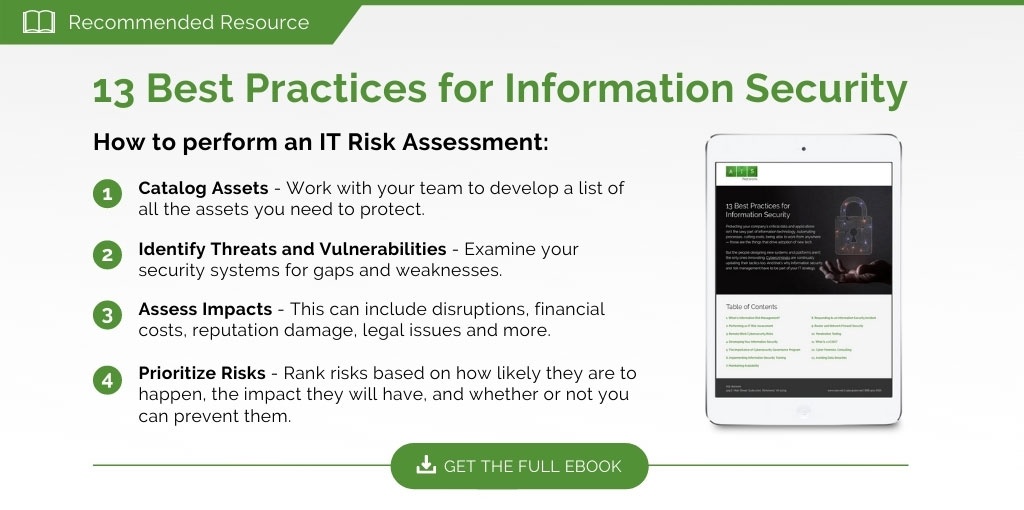
Managing risk is a fundamental part of doing business.
But as the technology and systems we use change, the risks we face evolve. A comprehensive information security program is the key to protecting your assets and maintaining compliance with industry and government standards. Better yet, it can be a lifesaver in the event that your systems are breached or compromised.
In this post, we’ll examine how to develop an information security program that minimizes the risk posed by IT threats and vulnerabilities to your business.
Do You Need an Information Security Program?
If your company doesn’t handle sensitive or proprietary data, you might think that developing an information security program isn’t something you need to worry about. But you’d be very, very wrong. While it’s important to protect your clients’ personal data, data breaches and cybercrime can expose you to a wide variety of losses:
- Financial Loss
- Reputation Damage
- Intellectual Property Loss
- Operations Downtime
- Customer Loss
- Stock Price Decline
- Loss of Market Share
- Employee Turnover
Did You Know? The average cybersecurity incident takes 197 days to discover. On average, 67% of the impact of a breach is felt in the first year after it occurs, 22% in the second year, and 11% in the third year.
The type of protection you need to implement will vary based on the information and infrastructure encompassed in your systems, but every information security program should cover three key factors.
3 Key Factors of Information Security Program
1. Confidentiality
Sensitive information must be protected from unauthorized access and sharing. Strong password policies, up-to-date encryption protocols, two-factor authentication, and unique user IDs can help with your network firewall and router security.
2. Integrity
Data must be kept whole and uncorrupted by unauthorized changes or accidents. Carefully structured user permissions, access controls, strict version controlling, and cloud backups are all tools that can help you protect your data’s integrity.
3. Availability
Your information must remain accessible to those who need it, even when things go wrong. This includes protecting against data loss and ensuring that your network is running efficiently and securely at all times. Sometimes delayed access can be just as damaging as lost access, especially with so many people working from home.

Developing a 4-Stage Strategy
Your information security program should include four main stages. Skipping any of these stages will compromise your information security program.
Prediction
Prevention
Detection
Response
Prediction
Before you can protect against cybersecurity risks, you have to understand what threats and vulnerabilities you’re working against. The best way to do this is by conducting an IT risk assessment and employing tools like penetration testing to identify weaknesses in existing protections. Be sure to account for risks associated with atypical circumstances like remote work so that your business is protected, no matter what.
Prevention
Once you’ve identified known vulnerabilities and threats, the next step in your information security program development is to take steps to reduce the chances of an incident occurring. At this stage, it’s important to establish a system of governance: a chain of command that ensures someone has ownership of the preventative measures put in place. Appointing a CISO (chief security information officer) can be valuable if your organization lacks a specific person to oversee this process.
Detection
All the prevention in the world can’t guarantee that you’ll never face a cybersecurity incident. Whether your systems are compromised by criminals with malevolent intent, an unintentional action by a member of your team, or a new weakness that simply went overlooked, the results can be catastrophic. Ensure you have regularly updated systems to monitor for unwanted intrusion so that you can respond quickly.
Response
If and when the worst happens, a carefully planned and rapidly enacted incident response plan can help ensure the threat is quickly contained and the damage mitigated. The response stage of your information security program should also include recovery aspects as needed. A solid understanding of cybersecurity law can help ensure you address all facets of the incident in a way that limits harm to your clients and your business.
Get Help From Information Security Experts
Do you need help developing or implementing an information security program? The experts at AISN can provide you with support for every stage of your plan, helping to protect your data and systems from threats and vulnerabilities. If you have questions about information security, we’d love to help. Drop us a line now.



